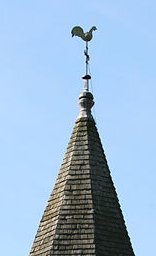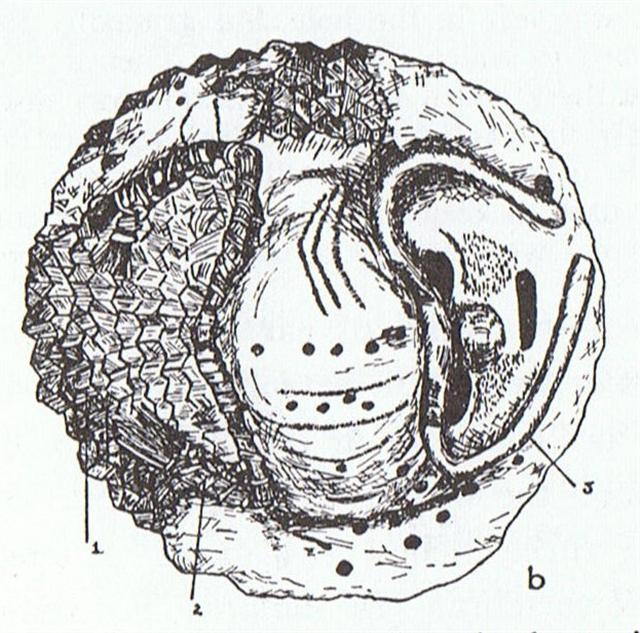|
6. The 'nestball' of earth which the dung beetle (κάραβος, a word remarkably similar to carapace and calebass) is holding in his claws - ... Jensen makes it [Cancer] the Tortoise of Babylonia, and it was so figured there and in Egypt 4000 B.C.; although in the Egyptian records of about 2000 B.C. it was described as a Scarabaeus, sacred, as its specific name sacer signifies, and an emblem of immortality. This was the Greek κάραβος, with its nestball of earth in its claws, an idea which occurs again even as late as the 12th century, when an illuminated astronomical manuscript shows a Water-beetle ... - was known, of course, to be filled with offspring. The Scarab of Sun is rolling our Earth forward ('ahead'), a rounded ball filled with us living beings, we can imagine. Wikipedia: "Several species of the dung beetle, most notably the species Scarabaeus sacer (often referred to as the sacred scarab), enjoyed a sacred status among the ancient Egyptians. Popular interpretation in modern academia theorizes the hieroglyphic image of the beetle represents a triliteral phonetic that Egyptologists transliterate as xpr or hpr and translate as 'to come into being', 'to become' or 'to transform'. The derivative term xprw or hpr(w) is variously translated as 'form', 'transformation', 'happening', mode of being' or 'what has come into being', depending on the context. It may have existential, fictional, or ontologic significance. The scarab was linked to Khepri ('he who has come into being'), the god of the rising sun. The ancients believed that the dung beetle was only male in gender, and reproduced by depositing semen into a dung ball. The supposed self-creation of the beetle resembles that of Khepri, who creates himself out of nothing ... Plutarch wrote: The race of beetles has no female, but all the males eject their sperm into a round pellet of material which they roll up by pushing it from the opposite side, just as the sun seems to turn the heavens in the direction opposite to its own course, which is from west to east." The moa with a long neck is looking down on a little henua (earth) sign in front of him, and then his fiery bird spirit seems to be crying out triumphantly in Ga3-3:
The open beak in Ga3-3 could illustrate how the sky roof is diverging from earth in spring, rising higher with time. The lower jaw is formed much like a henua sign. By painting Bright Fire green I have underlined how both Ga3-2 (Jupiter) and Ga3-3 (Venus) are needed for the procreation. 8 glyphs there are in the 1st period, but there are only 7 figures in a week - the 8th is the result of 'breaking Old Jupiter apart'. The left 'person' in Ga3-2 is drawn with an open perimeter - it is only a 'carcass'. Significantly it is the penis which is missing: ... Sorrowing, then, the two women placed Osiris's coffer on a boat, and when the goddess Isis was alone with it at sea, she opened the chest and, laying her face on the face of her brother, kissed him and wept. The myth goes on to tell of the blessed boat's arrival in the marshes of the Delta, and of how Set, one night hunting the boar by the light of the full moon, discovered the sarcophagus and tore the body into fourteen pieces, which he scattered abroad; so that, once again, the goddess had a difficult task before her. She was assisted, this time, however, by her little son Horus, who had the head of a hawk, by the son of her sister Nephtys, little Anubis, who had the head of a jackal, and by Nephtys herself, the sister-bride of their wicked brother Set. Anubis, the elder of the two boys, had been conceived one very dark, we are told, when Osiris mistook Nephtys for Isis; so that by some it is argued that the malice of Set must have been inspired not by the public virtue and good name of the noble culture hero, but by this domestic inadventure. The younger, but true son, Horus, on the other hand, had been more fortunately conceived - according to some, when Isis lay upon her dead brother in the boat, or, according to others, as she fluttered about the palace pillar in the form of a bird. The four bereaved and searching divinities, the two mothers and their two sons, were joined by a fifth, the moon-god Thoth (who appears sometimes in the form of an ibis-headed scribe, at other times in the form of a baboon), and together they found all of Osiris save his genital member, which had been swallowed by a fish. They tightly swathed the broken body in linen bandages, and when they performed over it the rites that thereafter were to be continued in Egypt in the ceremonial burial of kings, Isis fanned the corpse with her wings and Osiris revived, to become the ruler of the dead. He now sits majestically in the underworld, in the Hall of the Two Truths, assisted by forty-two assessors, one from each of the principal districts of Egypt; and there he judges the souls of the dead. These confess before him, and when their hearts have been weighed in a balance against a feather, receive, according to their lives, the reward of virtue and the punishment of sin ... Instead of a dung beetle the Easter Islanders evidently saw a cock as a better figure to impersonate Sun. It may have been their own idea or it may have been inspired by the missionaries:
"As with nearly any aspect of the body involved in sexual or excretory functions, the penis is the subject of many slang words and euphemisms for it, a particularly common and enduring one being 'cock'." (Wikipedia) Yet, the idea of a beetle seems to have been present on the island too. I have copied this picture from Métraux (Ethnology of Easter Island):
At the time when I read his book I reflected as follows: "It is a hat 'of plaited bulrush covered with painted tapa'. In the area marked 1 a part has been ripped off to show the plaiting below. The front part (right) is delineated by a kind of border the structure of which we recognize from that on the face of the sun god at Tiahuanaco. The eyebrow part of the border has a shape like viri. The right side is longer than the left. At the back of the hat there is a similar border, but here the ends are configured as Y, i.e. at the back side we find the female dark part. In the center there is a shell and possibly the creature is an insect. If we count the 'Y-tail' ends as 2 each we reach the sum 6 for the legs. The head of the creature is protruding in front of the shell, at the same time performing the function of a nose. On the left (female) side [of the shell] we see three wedge-formed lines (ribs?) as if to signal po, darkness. There are dots too on the shield, and maybe the insect is a lady-bug." |
|||||||||||||||||||||||||




